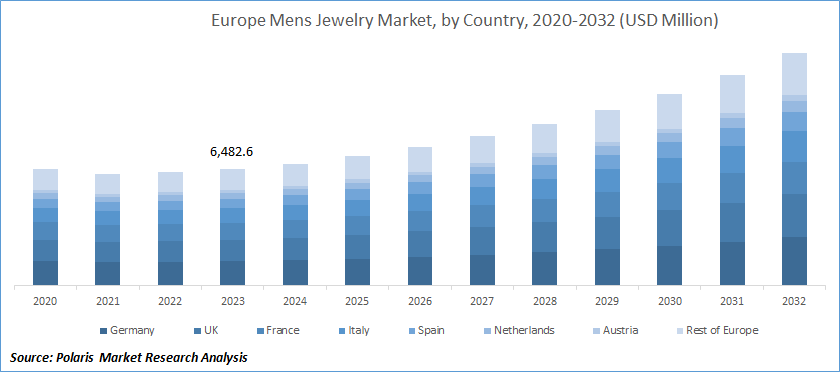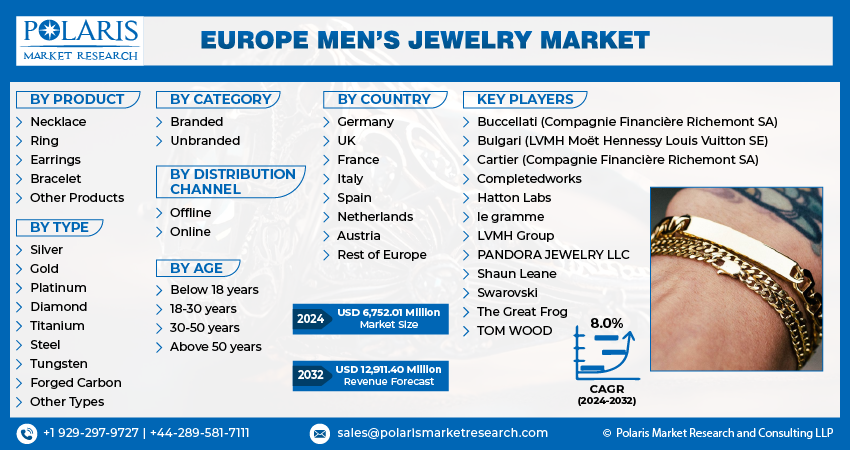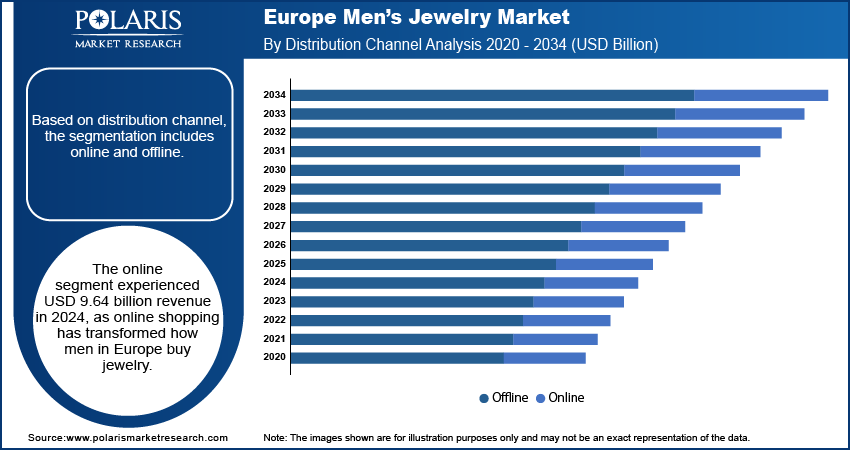
Europe Men’s Jewelry Market Share, Size, Trends, Industry Analysis Report, By Product (Necklace, Ring, Earrings, Bracelet, Other Products); By Type; By Category; By Distribution Channel; By Age; By Country; Segment Forecast, 2024 - 2032
- Published Date:Apr-2024
- Pages: 118
- Format: PDF
- Report ID: PM4861
- Base Year: 2023
- Historical Data: 2019-2022
Report Outlook
Europe men’s jewelry market size was valued at USD 6,482.63 million in 2023. The market is anticipated to grow from USD 6,752.01 million in 2024 to USD 12,911.40 million by 2032, exhibiting the CAGR of 8.0% during the forecast period.
Industry Trends
The men's jewelry market in Europe continues to witness steady growth driven by evolving fashion trends, changing societal attitudes towards male adornment, and the rising popularity of accessorizing among men. European consumers, particularly in countries with strong luxury fashion traditions such as Italy, France, and the United Kingdom, increasingly embrace a diverse range of jewelry pieces, including bracelets, necklaces, and rings. Thus, to cater this demand, manufacturers are introducing diverse collection of men’s jewelry.

To Understand More About this Research:Request a Free Sample Report
- For instance, in August 2022, The london based Hatton Labs has recently launched its latest AW22 collection, La Croisette. Designed for jewelry enthusiasts, this exquisite offer to delight with an array of crystal embellishments, sparkling metals, and an abundance of pearls.
Moreover, the European market benefits from the proliferation of online retail channels, providing consumers with greater accessibility to a wide array of men's jewelry styles and brands. While traditional precious metals like gold and silver remain popular choices, there is also a growing demand for contemporary designs featuring alternative materials such as stainless steel, titanium, and leather, catering to a broader spectrum of tastes and price points.
Additionally, sustainability and ethical sourcing are gaining prominence, with consumers showing increasing interest in jewelry crafted from recycled materials or produced through fair-trade practices. Overall, the men's jewelry market in Europe presents opportunities for both established luxury brands and emerging designers to capitalize on the growing demand for male-oriented accessories.
Key Takeaways
- Germany dominated the market and contributed over 20% of the market share in 2023
- By product category, the ring segment accounted for the largest Europe men’s jewelry market share in 2023
- By distribution channel, the online segment is anticipated to grow with a lucrative CAGR over the Europe men’s jewelry market forecast period
What are the market drivers driving the demand for market?
- Continuously evolving fashion trends drive the European men’s jewelry market growth.
The continuously evolving fashion landscape plays a pivotal role in driving the growth of the European men's jewelry market. As fashion trends continually shift and adapt to societal changes, there has been a notable transformation in the perception of men's accessorizing. Men are increasingly embracing jewelry as a means of self-expression, style, and individuality. This shift in attitude towards men's fashion has opened up new opportunities for jewelry designers and retailers to cater to a burgeoning market segment. With each passing trend cycle, there emerges a fresh demand for innovative and contemporary designs that resonate with the modern man's aesthetic preferences. Thus, the dynamic nature of fashion trends catalyzes the expansion of the European men's jewelry market, driving both consumer interest and industry innovation.

Which factor is restraining the demand for market?
- Competition from other accessories affects the Europe men’s jewelry market growth.
Competition from other accessories poses a significant challenge to the growth of the Europe men's jewelry market. Men have a plethora of accessory options to choose from, including watches, belts, hats, and bags, all vying for their discretionary spending. With a finite budget for accessories, men prioritize other items over jewelry, especially if they perceive them to be more essential or versatile. This intense competition limits the market's potential growth as men allocate their fashion budget across various accessory categories.
Also, the established popularity and utility of accessories like watches may overshadow the appeal of jewelry, particularly for consumers who prefer functional items over purely decorative ones. As a result, the Europe men's jewelry market faces the challenge of stiff competition from a wide collection of alternative accessories, thereby restraining its growth potential.
Report Segmentation
The market is primarily segmented based on product, type, category, distribution channel, age, and country.
|
By Product |
By Type |
By Category |
By Distribution Channel |
By Age |
By Country |
|
|
|
|
|
|
To Understand the Scope of this Report:Speak to Analyst
Category Wise Insights
By Product Insights
Based on product category analysis, the market has been segmented on the basis of necklace, ring, earrings, bracelet, and other products. In 2023, the ring segment emerged as the dominant segment in Europe's men's jewelry market since rings have long held symbolic significance in European culture, often serving as markers of status, commitment, or personal style. As societal norms evolve, more men are embracing the idea of wearing rings as a form of fashion statement.
Also, the versatility of rings allows them to be easily integrated into various outfits and occasions, ranging from casual wear to formal attire. The availability of a diverse range of designs, materials, and styles further contributes to the popularity of rings among European men, catering to a wide spectrum of tastes and preferences. As a result, the ring segment has emerged as a dominant segment in Europe's men's jewelry market, reflecting shifting consumer attitudes and preferences toward men's accessorizing.
By Distribution Channel Insights
Based on distribution channel analysis, the market has been segmented on the basis of Offline and Online. The online segment is anticipated to grow with a significant CAGR over the forecast period in Europe's men's jewelry market. E-commerce platforms are becoming increasingly prevalent, giving consumers easy and convenient access to a wide variety of men's jewelry options.
Also, marketing and advertising efforts have become more digitalized, enabling online retailers to reach a wider audience, including tech-savvy millennials and Gen Z consumers who are more inclined toward online shopping. Advancements in technology, such as virtual try-on features and augmented reality applications, enhance the online shopping experience, mitigating concerns related to fit and style. As consumer preferences continue to tilt towards online shopping, the online segment is poised to experience remarkable growth in the market.

Country-wise Insights
Germany
Germany leads the men’s jewelry market in Europe. The market in Germany is experiencing a notable shift as societal norms evolve and fashion trends diversify. Historically, Germany has not been as prominent in men's jewelry consumption compared to some other countries. Still, recent years have witnessed a growing interest among German consumers in accessorizing and personal style expression.
One significant trend driving this shift is the changing perception of masculinity. Traditional stereotypes around men's fashion are giving way to more fluid and inclusive definitions, allowing men to feel more comfortable and confident in experimenting with jewelry as part of their wardrobe. This cultural shift is reflected in the increasing acceptance and adoption of male jewelry in Germany, particularly among younger generations who view jewelry as a means of self-expression and individuality. Furthermore, popular culture and social media influence consumer preferences significantly. Celebrities, influencers, and fashion icons often showcase stylish jewelry looks, inspiring men to incorporate similar accessories into their outfits. This trend awareness, coupled with the accessibility of online shopping platforms, has made it easier for German consumers to discover and purchase a wide range of men's jewelry options from both domestic and international brands.
Italy
Italy is anticipated to grow with a significant CAGR ove rthe forecast period in the Europe men’s jewelry market. The men's jewelry market in Italy is vibrant and dynamic, reflecting the country's rich heritage in craftsmanship and design. Italian men have a long-standing tradition of appreciating fine accessories, including jewelry, as a means of expressing their style and status. The market offers a diverse range of products, from classic pieces to more contemporary and avant-garde designs, catering to the varied tastes of Italian consumers. Luxury brands play a significant role in shaping the men's jewelry market in Italy, with renowned Italian houses such as Bulgari, Damiani, and Pomellato. These brands are known for their exquisite craftsmanship, use of high-quality materials, and timeless designs, attracting both domestic and international clientele.
For instance, Damiani Jewelry is a luxury goods and jewelry manufacturing company that specializes in high jewelry, luxury jewels, and luxury goods. The company offers bracelets, charms, necklaces, and rings in men’s jewelry. Additionally, there is a growing interest in independent designers and artisanal jewelry makers who offer unique and bespoke pieces tailored to individual preferences. This trend reflects a broader shift towards personalized and artisanal products in the fashion industry, aligning with Italian consumers' appreciation for quality and craftsmanship.
Competitive Landscape
The key players in the industry leverage various strategies, such as product innovation, extensive distribution networks, and strategic partnerships, to maintain their competitive edge. Established luxury brands capitalize on their heritage, craftsmanship, and brand reputation to appeal to discerning consumers seeking exclusivity and prestige. Simultaneously, emerging brands focus on agility, creativity, and accessibility to carve out a niche in the market. As consumer preferences continue to evolve and the market landscape shifts, competition intensifies, driving players to constantly innovate and differentiate their offerings to capture market share in the dynamic European men's jewelry market.
Some of the major players operating in the European market include:
- Buccellati (Compagnie Financière Richemont SA)
- Bulgari (LVMH Moët Hennessy Louis Vuitton SE)
- Cartier (Compagnie Financière Richemont SA)
- Completedworks
- Hatton Labs
- le gramme
- LVMH Group
- PANDORA JEWELRY LLC
- Shaun Leane
- Swarovski
- The Great Frog
- TOM WOOD
Recent Developments
- In August 2023, Mr Porter expanded its investment in the fine jewelry category, enhancing its range with renowned brands such as Carolina Bucci, Jacquie Aiche, 42 Suns, Duffy Jewellery, Elhanati, Suzanne Kalan, Lito, Yvonne Léon, and Sydney Evan.
- In September 2023, Swarovski introduced its Galaxy Collection in partnership with IGI, representing the brand's first foray into fine jewelry. Designed under the creative guidance of Giovanna Engelbert, Swarovski's global creative director, this new line showcases lab-grown diamonds certified by IGI. Swarovski plans to extend its fine jewelry category worldwide, encompassing all flagship stores and key markets such as Austria, China, South Korea, Japan, the U.K., Italy, France, and the United Arab Emirates.
Report Coverage
The Europe Men’s Jewelry market report emphasizes on key countries across the region to provide better understanding of the product to the users. Also, the report provides market insights into recent developments, trends and analyzes the technologies that are gaining traction around the region. Furthermore, the report covers in-depth qualitative analysis pertaining to various paradigm shifts associated with the transformation of these solutions.
The report provides detailed analysis of the market while focusing on various key aspects such as competitive analysis, product, type, category, distribution channel, age, and their futuristic growth opportunities.
Men’s Jewelry Market Report Scope
|
Report Attributes |
Details |
|
Market size value in 2024 |
USD 6,752.01 million |
|
Revenue forecast in 2032 |
USD 12,911.40 million |
|
CAGR |
8.0% from 2024 – 2032 |
|
Base year |
2023 |
|
Historical data |
2019 – 2022 |
|
Forecast period |
2024 – 2032 |
|
Quantitative units |
Revenue in USD million and CAGR from 2024 to 2032 |
|
Segments covered |
By Product, By Type, By Category, By Distribution Channel, By Age, By Country |
|
Regional scope |
UK, France, Germany, Italy, Spain, Netherlands, Russia, Rest of Europe |
|
Customization |
Report customization as per your requirements with respect to countries, region and segmentation. |
FAQ's
The key companies in Europe Men's Jewelry Market are Buccellati (Compagnie Financière Richemont SA), Bulgari (LVMH Moët Hennessy Louis Vuitton SE)
Europe men’s jewelry market exhibiting the CAGR of 8.0% during the forecast period.
Europe Men's Jewelry Market report covering key segments are product, type, category, distribution channel, age, and country.
The key driving factors in Europe Men's Jewelry Market are Endorsements by celebrities and influencers fuelling the men's jewelry adoption in Europe
Europe Men’s Jewelry Market Size Worth USD 12,911.40 Million by 2032.
